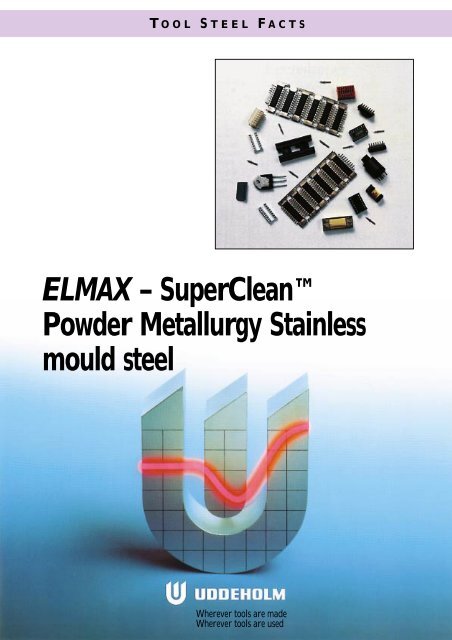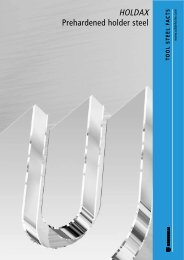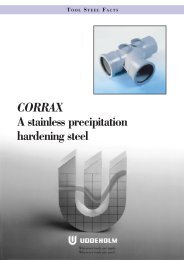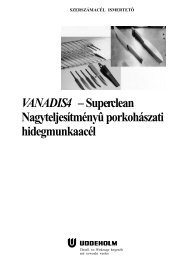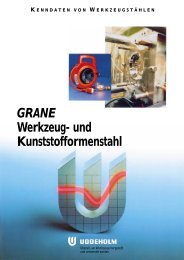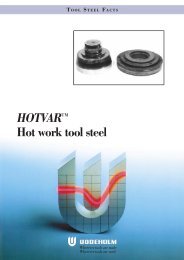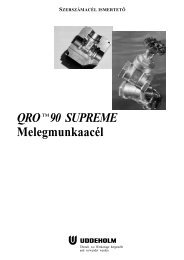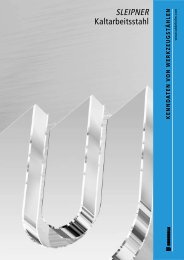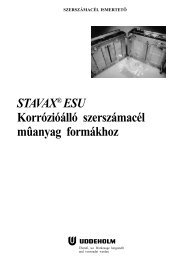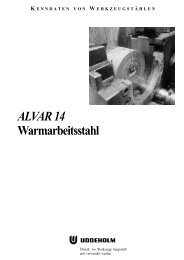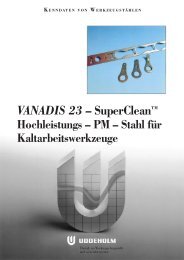download - Uddeholm
download - Uddeholm
download - Uddeholm
Create successful ePaper yourself
Turn your PDF publications into a flip-book with our unique Google optimized e-Paper software.
T O O L S T E E L F A C T S<br />
ELMAX – SuperClean<br />
Powder Metallurgy Stainless<br />
mould steel<br />
Wherever tools are made<br />
Wherever tools are used
ELMAX<br />
This information is based on our present state of knowledge and is<br />
intended to provide general notes on our products and their uses.<br />
It should not therefore be construed as a warranty of specific<br />
properties of the products described or a warranty for fitness for a<br />
particular purpose.<br />
2
ELMAX<br />
General<br />
ELMAX is a high chromium-vanadiummolybdenum-alloyed<br />
steel with the following<br />
characteristics:<br />
• High wear resistance<br />
• High compressive strength<br />
• Corrosion resistant<br />
• Very good dimensional stability.<br />
High wear resistance is normally connected to low<br />
corrosion resistance and vice versa. In ELMAX it<br />
has however been able to achieve this unique combination<br />
of properties by a powder-metallurgybased<br />
production.<br />
ELMAX offers a possibility to make long-life, lowmaintenance<br />
moulds for the best overall moulding<br />
economy.<br />
Typical C Si Mn Cr Mo V<br />
analysis % 1,7 0,8 0,3 18,0 1,0 3,0<br />
Delivery<br />
condition Soft annealed approx. 250 Brinell<br />
Colour code Blue/black<br />
Properties<br />
PHYSICAL DATA<br />
Hardened and tempered to 58 Rockwell C.<br />
Temperature (20°C) (200°C) (400°C)<br />
68°F 392°F 752°F<br />
Density<br />
kg/m 3 7 800 7 750 7 700<br />
lbs/in. 0,282 0,280 0,277<br />
MODULUS OF ELASTICITY<br />
N/mm 2 240 000 230 000 220 00<br />
psi 34,8 x 10 6 33,4 x 10 6 31,9 x 10 6<br />
Coefficient of thermal exp,<br />
per °C from 20°C – 10,7 x 10 -6 11,6 x 10 -6<br />
per °F from 68°F – 6,0 x 10 -6 6,5 x 10 -6<br />
Thermal conductivity*<br />
W/m °C – 21 23<br />
Btu in/ft 2 h °F – 153 168<br />
Specific heat<br />
J/kg °C 460 – –<br />
Btu/lb °F 0,110 – –<br />
*Thermal conductivity is difficult to measure. The scatter<br />
may be as high as ±15%.<br />
COMPRESSIVE STRENGTH<br />
Applications<br />
New types of engineering plastics, with high filler<br />
contents, place greater demands on the tooling<br />
material, in terms of wear resistance and corrosion<br />
resistance. ELMAX has been specially developed<br />
for high-tech applications. These include products<br />
within the electronic industry such as connectors,<br />
plugs, switches, resistors, integrated circuits, etc.<br />
ELMAX can also be used in the food processing<br />
industry, where a combination of corrosion resistance<br />
and wear resistance is required for cutting<br />
applications.<br />
The figures are to be considered approximate.<br />
Hardness 60 RC 55 RC 50 RC<br />
Compressive<br />
strength Rm<br />
N/mm 2 3 000 2 700 2 300<br />
tsi 195 175 150<br />
psi 435 000 390 000 335 000<br />
Yield point<br />
Rp0,2<br />
N/mm 2 2 300 2 150 1 800<br />
tsi 150 140 120<br />
psi 335 000 310 000 260 000<br />
CORROSION RESISTANCE<br />
Molds made from ELMAX will have good resistance<br />
to corrosion when moulding corrosive plastics<br />
under normal production conditions.<br />
A tool for injection moulding of a camera part.<br />
Insert mould material; ELMAX, plastic moulded;<br />
Polycarbonate (30% GR).<br />
3
ELMAX<br />
Heat treatment<br />
SOFT ANNEALING<br />
Protect the steel and heat through to 980°C<br />
(1800°F), holding time 2h. Then cool in furnace<br />
10°C (20°F)/h to 850°C (1560°F). Holding time<br />
10h. Cool slowly to 750°C (1380°F). Then freely<br />
in air.<br />
TEMPERING<br />
Choose the tempering temperature according to<br />
the hardness required by reference to the tempering<br />
graph. Temper twice with intermediate cooling<br />
to room temperature. Lowest tempering temperature<br />
180°C (360°F). Holding time at tempering<br />
temperature minimum 2 hours.<br />
Tempering graph<br />
STRESS-RELIEVING<br />
Hardness, RC Retained austenite %<br />
62<br />
After rough machining the tool should be heated<br />
Austenitizing temperature 1100°C<br />
60<br />
through to 650°C (1200°F), holding time 2 hours.<br />
(2010°F)<br />
1080°C<br />
Cool slowly to 500°C (930°F) then freely in air. 58 (1980°F)<br />
56 1050°C<br />
10<br />
(1920°F)<br />
HARDENING<br />
54<br />
8<br />
Preheating temperature: 600–850°C (1110–1560°F).<br />
52<br />
6<br />
Austenitizing temperature: 1050–1100°C (1920– 50<br />
4<br />
Retained austenite<br />
2010°F), normally 1080°C(1980°F).<br />
48 1050°C (1920°F)<br />
2<br />
46<br />
0<br />
100 200 300 400 500 600 °C<br />
Temperature Holding* Hardness<br />
M f 9 245 6285<br />
time<br />
before<br />
°C °F minutes tempering<br />
210 390 570 750 930 1110 °F<br />
1050 1920 30 60 RC<br />
Tempering temperature, 2 x 2h<br />
1080 1980 30 61 RC<br />
1100 2010 30 62 RC<br />
* Holding time = time at austenitizing temperature after the<br />
tool is fully heated through.<br />
Protect the part against decarburization and<br />
oxidation during hardening.<br />
CCT-graph<br />
Austenitizing temperature 1050°C (1920°F). Holding time 30 minutes.<br />
°F °C<br />
2000 1100<br />
1800 1000<br />
A C1f<br />
1600<br />
900<br />
A C1s<br />
1400<br />
800<br />
Pearlite<br />
700<br />
1200<br />
600<br />
Graph HV T 800–500<br />
1000<br />
No. 10 Kg s<br />
500<br />
1 803 1<br />
800<br />
2 772 10<br />
400<br />
3 724 105<br />
Bainite<br />
600<br />
4 634 576<br />
300<br />
M 5 634 1048<br />
s<br />
400 200<br />
6 536 2095<br />
1 2 3 4 5 6 7 8 9<br />
7 503 3143<br />
200 100<br />
Martensite<br />
8 270 4190<br />
1 10 100 1000 10 000 100 000 Seconds<br />
1 10 100 1000 Minutes<br />
1 10 100 Hours<br />
0.0079 0.059 0.394 3.54 23.6<br />
0.2 1.5 10.0 90.0 600.0<br />
Air cooling of<br />
bars, Ø inch<br />
mm<br />
4
ELMAX<br />
QUENCHING MEDIA<br />
• Forced air/gas<br />
• Fluidized bed or salt bath 20/200–550°C<br />
(68/390–1020°F), then cool in air.<br />
Note: In order to obtain optimum properties, the<br />
cooling rate should be as fast as is concomitant<br />
with acceptable distortion. Temper immediately<br />
the tool reaches 50–70°C (120–160°F).<br />
SUB-ZERO TREATMENT<br />
Parts requiring maximum dimensional stability<br />
should be sub-zero treated as volume changes<br />
otherwise may arise.<br />
Immediately after quenching the piece should be<br />
sub-zero treated to between –40°C to –120°C<br />
(–40°F to –180°F) followed by tempering.<br />
Treatment for 1–3 hours will give a hardness increase<br />
of 1–3 HRC.<br />
Avoid intricate shapes as there is a risk of cracking.<br />
DIMENSIONAL CHANGE OF ELMAX<br />
DURING HEAT TREATMENT<br />
Illustration of the effect from austenitizing temperature<br />
and subzero cooling.<br />
%<br />
0,150<br />
0,125<br />
0,100<br />
0,075<br />
0,050<br />
0,025<br />
0,000<br />
1234<br />
After 1234<br />
hardening After hardening<br />
and tempering<br />
1234<br />
1234<br />
1234 1234<br />
1234 1234<br />
1234<br />
1234<br />
1234<br />
1234<br />
123<br />
123<br />
L W T L W T<br />
Austenitizing: 1050°C (1920°F) 1050°C (1920°F)<br />
30 min 30 min<br />
Quenching<br />
medium: air air<br />
Sub-zero<br />
treatment: – –60°C (–75°F)<br />
Tempering: 230°C (440°F) 2h + 2h 230°C (440°F) 2h + 2h<br />
%<br />
0,150<br />
0,125<br />
0,100<br />
0,075<br />
0,050<br />
0,025<br />
0,000<br />
After<br />
hardening<br />
1234<br />
1234<br />
1234<br />
After<br />
hardening<br />
and tempering<br />
123<br />
123<br />
123<br />
123<br />
123<br />
123<br />
123<br />
123<br />
123<br />
123<br />
123<br />
1234<br />
1234<br />
1234<br />
1234<br />
1234<br />
1234<br />
123<br />
123<br />
123<br />
123<br />
123<br />
123<br />
1234<br />
1234<br />
1234<br />
1234<br />
1234<br />
1234<br />
L W T L W T<br />
Austenitizing: 1100°C (2010°F) 1100°C (2010°F)<br />
30 min 30 min<br />
Quenching<br />
medium: air air<br />
Sub-zero<br />
treatment: – –60°C (–75°F)<br />
Tempering: 230°C (440°F) 2h + 2h 230°C (440°F) 2h + 2h<br />
Mold for tape-casettes with inserts of ELMAX.<br />
Above test has been performed on sample size:<br />
40 x 40 x 40 mm (1,6 x 1,6 x 1,6 in.).<br />
5
ELMAX<br />
Cutting data<br />
–recommendations<br />
The cutting data below are to be considered as<br />
guiding values which must be adapted to existing<br />
local conditions.<br />
TURNING<br />
Turning with Turning with<br />
carbide<br />
high speed<br />
Cutting data<br />
steel<br />
parameters Rough turning Fine turning Fine turning<br />
Cutting<br />
speed (v C<br />
)<br />
m/min. 50–80 80–130 15<br />
f.p.m. 165–265 265–430 50<br />
Feed (f)<br />
mm/r 0,3–0.6 –0,3 –0,3<br />
i.p.r. 0,01–0,024 –0,01 –0,01<br />
Depth<br />
of cut (a P )<br />
mm 2–6 –2 –2<br />
inch 0,08–0,24 –0,08 –0,08<br />
Carbide<br />
designation<br />
ISO K15* K15* –<br />
US C2* C2*<br />
*Use a wear resistant Al 2<br />
O 3<br />
coated carbide grade, for<br />
example Sandvik Coromant GC 3015 or Seco TP05.<br />
End milling<br />
Type of end mill<br />
Carbide<br />
Cutting data Solid indexable High speed<br />
parameters carbide insert steel<br />
Cutting<br />
speed (v C )<br />
m/min. 20 50–80 9 1)<br />
f.p.m. 66 165–265 30 1)<br />
Feed (f Z )<br />
mm/tooth 0,03–0,20 2) 0 0,08–0,20 2) 0 0,050–0,35 2) 0<br />
in/tooth 0,001–0,008 2) 0,003–0,008 2) 0,002–0,014 2)<br />
Carbide<br />
designation<br />
ISO K20 K15 3) –<br />
US C2 C2 3) –<br />
1)<br />
For coated HSS end mill v C<br />
~ 16 m/min. (53 f.p.m.).<br />
2)<br />
Depending on radial depth of cut and cutter diameter.<br />
3)<br />
Use a wear resistant Al 2<br />
O 3<br />
coated carbide grade.<br />
DRILLING<br />
High speed steel twist drills<br />
Drill diameter Cutting speed (v c ) Feed (f)<br />
mm inch m/min. f.p.m. mm/r i.p.r.<br />
– 5 –3/16 9* 30* 0,05–0,15 0,002–0,006<br />
5–10 3/16–3/8 9* 30* 0,15–0,25 0,006–0,010<br />
10–15 3/8–5/8 9* 30* 0,25–0,35 0,010–0,014<br />
15–20 5/8–3/4 9* 30* 0,35–0,40 0,014–0,016<br />
* For coated HSS drills v C<br />
~13 m/min. (43 f.p.m.).<br />
MILLING<br />
Face and square shoulder milling<br />
Milling with Milling with<br />
carbide<br />
high speed<br />
Cutting data<br />
steel<br />
parameters Rough milling Fine milling Fine milling<br />
Cutting<br />
speed (v C )<br />
m/min. 70–90 90–120 9<br />
f.p.m. 230–300 300–395 30<br />
Feed (f Z)<br />
mm/tooth 0,2–0,4 0,1–0,2 0,1<br />
in/tooth 0,008–0,016 0,004–0,008 0,004<br />
Depth<br />
of cut (a p )<br />
mm 2–5 –2 –2<br />
in 0,08–0,20 0,08 –0,08<br />
Carbide<br />
designation<br />
ISO K15* K15* –<br />
US C2* C2* –<br />
* Use a wear resistant Al 2<br />
O 3<br />
coated carbide grade, for<br />
example Sandvik Coromant GC 3015 or Seco T10M.<br />
Carbide drills<br />
Type of drill<br />
Cutting data Indexable Solid Brazed<br />
parameters insert carbide carbide 1)<br />
Cutting<br />
speed (v C )<br />
m/min. 80–130 40 30<br />
f.p.m. 265–430 130 100<br />
Feed (f)<br />
mm/r 0,05–0,25 2) 0,10–0,25 2) 0,15–0,25 2)<br />
i.p.r. 0,002–0,01 2) 0,004–0,01 2) 0,006–0,01 2)<br />
1)<br />
Drills with internal cooling channels and brazed carbide<br />
tip.<br />
2)<br />
Depending on drill diameter.<br />
6
ELMAX<br />
GRINDING<br />
A general grinding wheel recommendation is<br />
given below. More information can be found in the<br />
<strong>Uddeholm</strong> brochure “Grinding of Tool Steel”.<br />
Wheel recommendation<br />
Type of Soft annealed Hardened<br />
grinding condition condition<br />
Face grinding<br />
straight wheel A 46 HV B107 R75 B3 1)<br />
3SG 46 GVS 2)<br />
C 46 GV<br />
Face grinding<br />
segments A 24 GV 3SG 46 FVSPF 2)<br />
A 46 FV<br />
Cylindrical grinding A 60 JV B126 R75 B3 1)<br />
5SG 70 IVS 2)<br />
C 60 IV<br />
Internal grinding A 46 JV B107 R75 B3 1)<br />
3SG 60 JVS 2)<br />
C 60 HV<br />
Profile grinding A 100 LV B107 R100 V 1)<br />
5SG 80 JVS 2)<br />
C 120 HV<br />
1)<br />
If possible use CBN wheels for this application.<br />
2)<br />
Grinding wheel from Norton Co.<br />
Property<br />
comparison chart<br />
<strong>Uddeholm</strong> Wear Corrosion Dimensional<br />
steel grade resistance resistance stability<br />
ELMAX<br />
RIGOR<br />
STAVAX<br />
Further information<br />
Please contact your local <strong>Uddeholm</strong> office for further<br />
information on the selection, heat treatment,<br />
application and availability of <strong>Uddeholm</strong> tool steels.<br />
Electrical-discharge<br />
machining<br />
If EDM’ing, (“spark-erosion”) is performed in the<br />
hardened and tempered condition the tool should<br />
then be given an additional temper at about 20°C<br />
(50°F) below the previous tempering temperature.<br />
A mould for production of connectors. ELMAX is used<br />
as insert material.<br />
7


